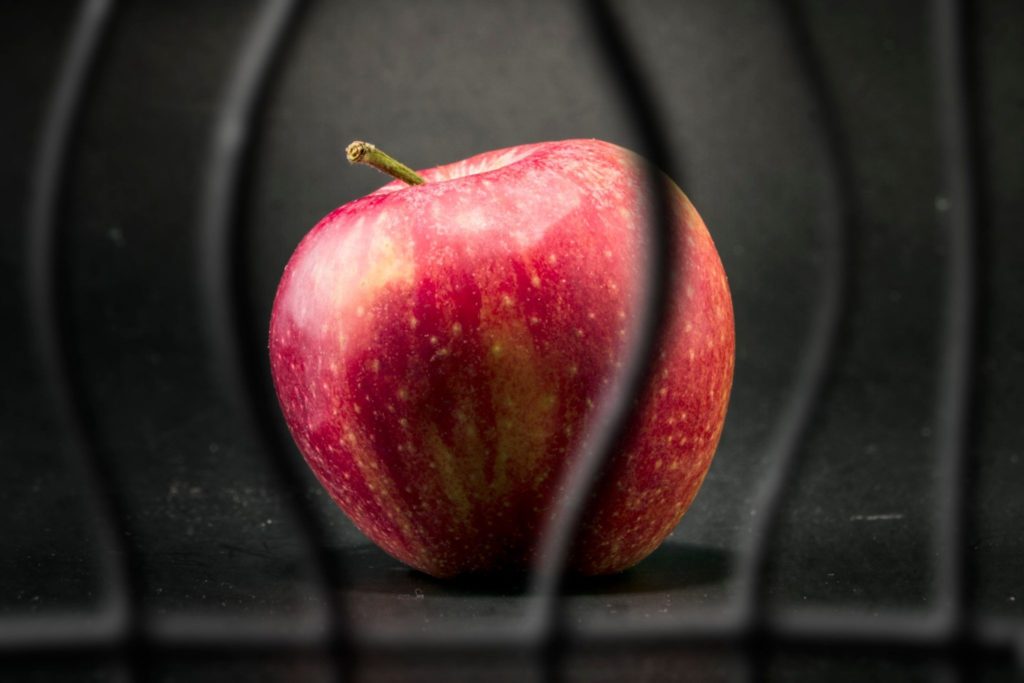In December 2016, Gov. Snyder signed a bill asking schools to consider using restorative practices in place of zero-tolerance policies like suspension and expulsion.
Zero-tolerance policies are exactly what they sound like:
They’re no-nonsense forms of school discipline where students are removed from school for committing infractions that are deemed unacceptable.
Historically, these policies were designed to keep schools and students safe by protecting students from dangers like drug use, gang affiliation and violence. While the intentions were noble, critics of these policies point to the array of unintended outcomes that have done more harm than good.
Why are educational leaders pushing for restorative justice?
It’s a paradigm shift away from zero tolerance and toward a system rooted in values of respect, accountability, healing and empathy.
This shift toward restorative justice is a topic we will continue to cover in future installments of our blog series on Restorative Justice in Michigan Schools.
There’s a wealth of research telling us that zero-tolerance policies don’t work. The law is just now beginning to catch up.
Here are four ways that zero tolerance negatively affects students:
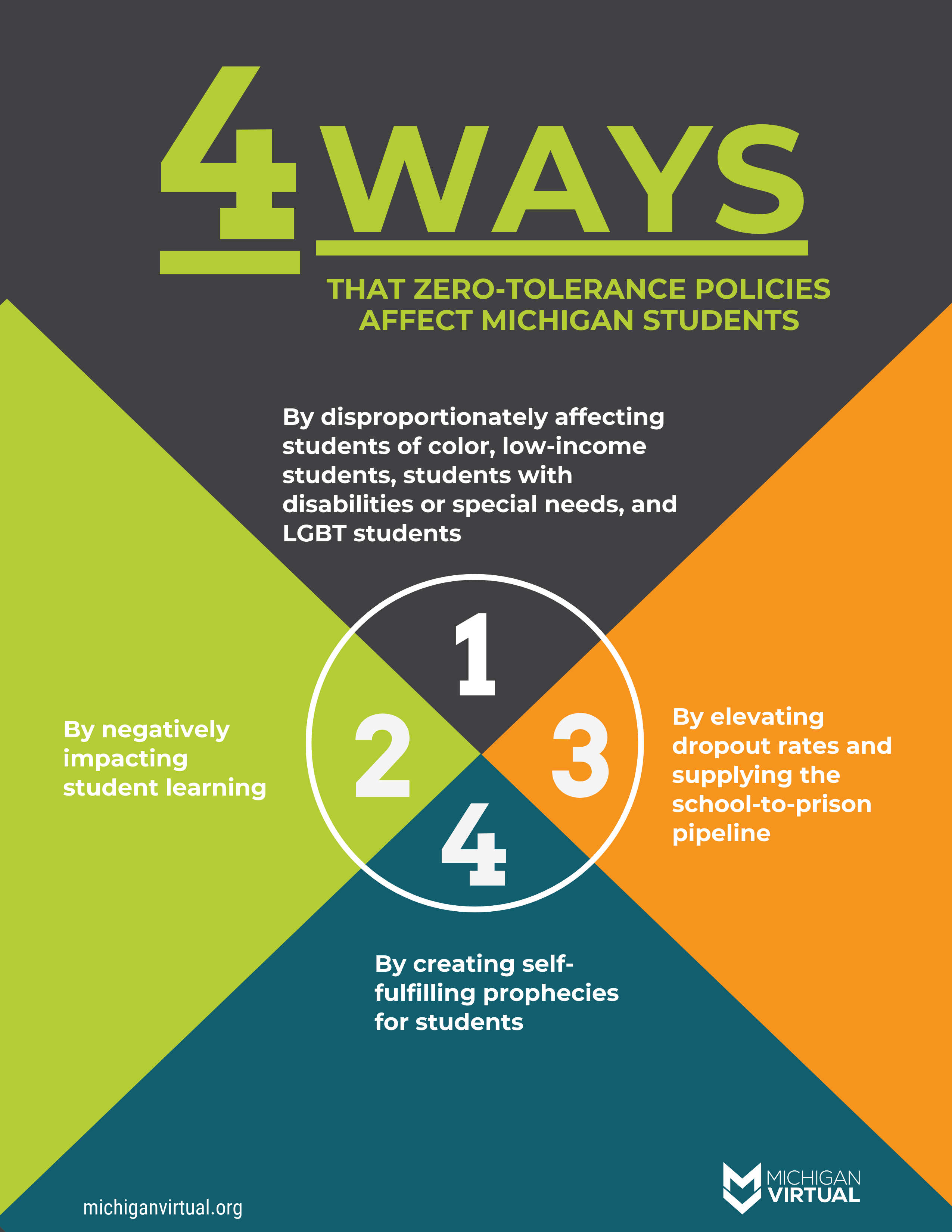
#1 — Zero-tolerance policies disproportionately affect students of color, low-income students, students with disabilities or special needs, and LGBT students
The evidence is nearly undeniable. Zero-tolerance policies do not affect all student groups equally. In fact, certain groups of students are dramatically more likely to be punished or removed from school under the reign of zero tolerance.
The victims of zero-tolerance policies include:
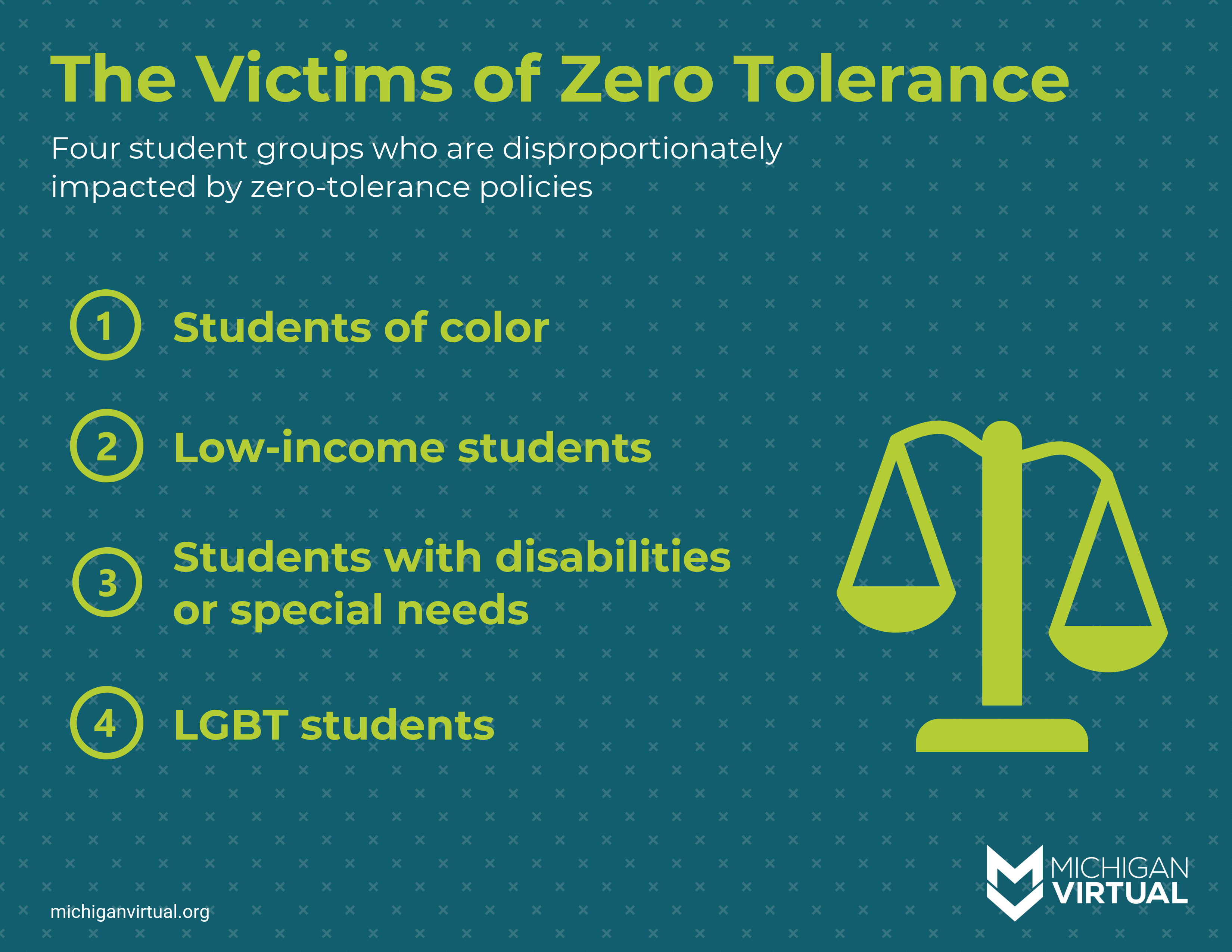
You can find research supporting these trends here, here, and here.
Unfortunately, Michigan schools are not free from these disparities. In 2017, for example, Ann Arbor Public Schools performed an investigation into their own zero-tolerance policies and found that 11.1 percent of low-income students were suspended during the 2015-16 school year, as compared to only 1.8 percent of affluent students.
![Economic disparity in Ann Arbor's zero tolerance policy [pie chart explained verbally in paragraph above]](https://michiganvirtual.org/wp-content/uploads/2018/12/economic-disparity-1.png)
The same report found that African-American students constituted a disproportionate number of Ann Arbor Public School’s suspensions during the 2015-16 school year. Despite the fact that only 16.4 percent of Ann Arbor high school’s population was African American at this time, this group accounted for 43.5 percent of the year’s suspensions.
![Racial Disparity in Ann Arbor's Zero Tolerance Policies [chart explained verbally in paragraph above]](https://michiganvirtual.org/wp-content/uploads/2018/12/racial-disparity.png)
But what’s unique about Ann Arbor Public Schools is their efforts to acknowledge and address these issues. Over the past six years, they have used restorative justice to transform their school and to reduce their suspension rates.
#2 — Zero-tolerance policies negatively impact student learning
Here’s another big problem with zero-tolerance policies:
When students are suspended or expelled, they’re missing valuable time in class.
When it comes to Michigan, the negative effects of zero-tolerance policies can be seen in data on our state’s student expulsions from previous years.
Across the state of Michigan, a total 1,319 students were expelled during the 2015-16 school year. Out of this grouping, about 40 percent of expulsions resulted in 180 days of missed school. That’s roughly the length of one full academic year.
That’s quite a bit of learning lost.
Critics of zero-tolerance policies argue that there must be a better way to help misbehaving students grow than kicking them out of the very institutions that promise to help them learn.
Compiled by staff at MLive.com, the following graphs — based on student data from 10 Michigan counties — reveal just how many students we collectively expelled during the 2015-16 school year, along with the length of their expulsions:
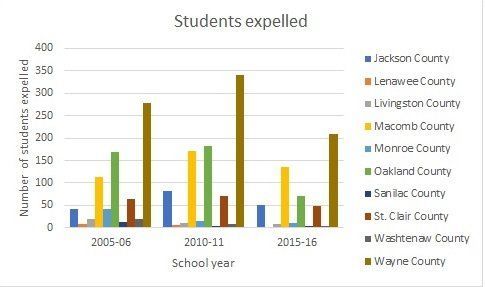
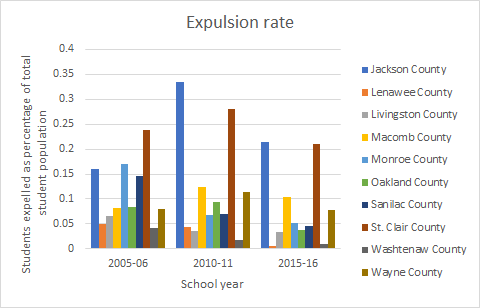
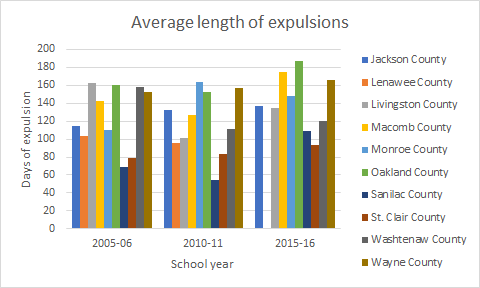
If you’re curious, you can use this student explusion database at MLive.com to search for how many students were expelled from your school district (and for what reason) during the 2015-16 school year.
#3 — Zero-tolerance policies elevate dropout rates and supply the school-to-prison pipeline
By dismantling zero-tolerance policies, education reformers also hope to lower dropout rates and combat the school-to-prison pipeline, a phenomenon where students who are suspended or expelled are far more likely to end up in prison.
According to the ACLU, students who face suspension or expulsion are three times more likely to be in contact with the juvenile justice system during the following year.
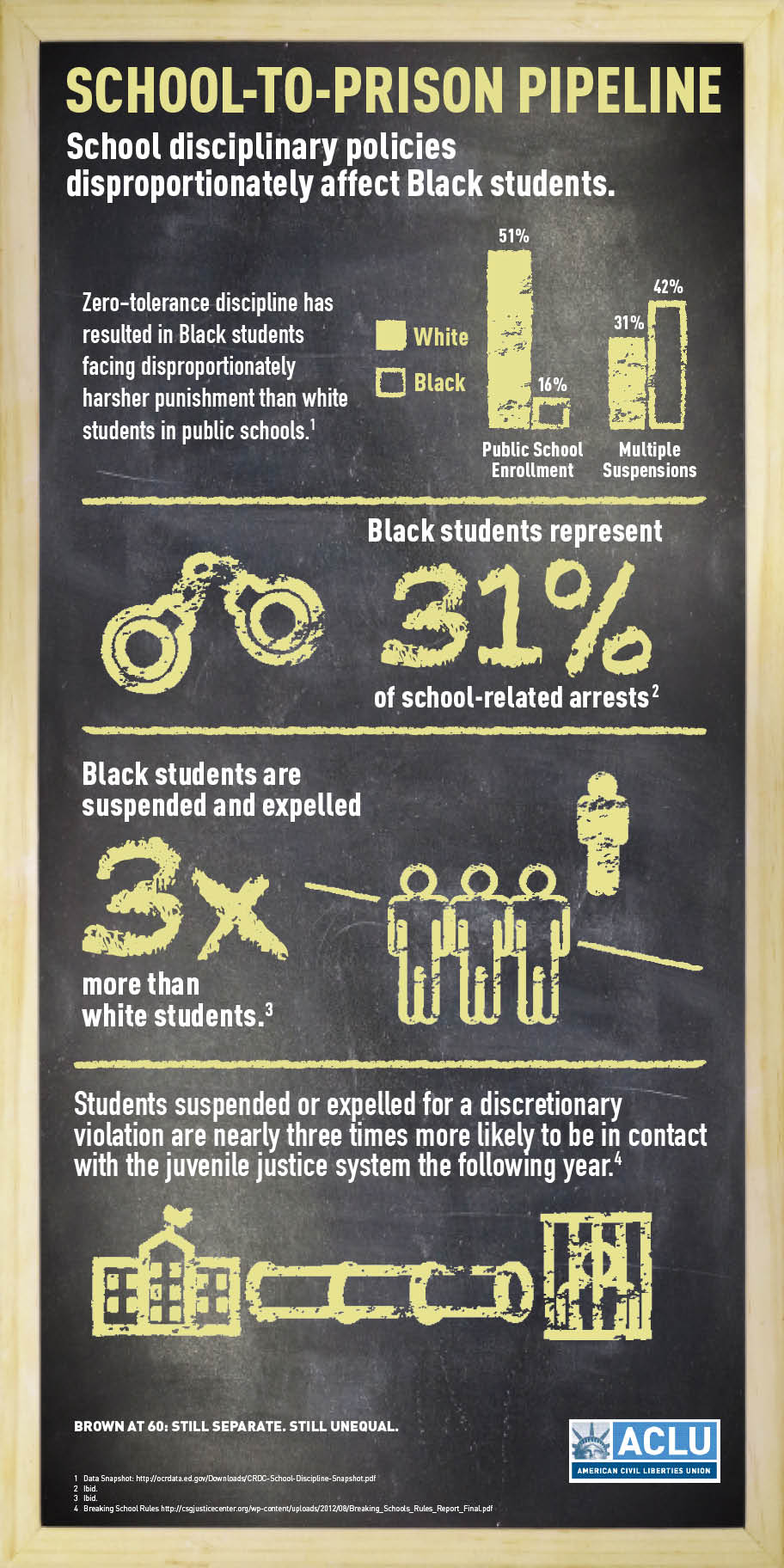
For students struggling with gang identity, the effects of zero tolerance may be equally dramatic. At many schools in the United States, any displays of gang affiliation are grounds for automatic suspension or expulsion.
Challenging the efficacy of this approach, Jean Klasovsky — a social-emotional learning specialist for Chicago Public Schools — argues:
“If these children ever had any doubt in their mind about where they belonged, we are sending them a message loud and clear: The schools don’t want them. The gangs do.”
Critics argue:
Rather than pushing kids out of school, we should be doing everything they can to prevent students from falling deeper and deeper into this vicious cycle.
The goal with restorative justice is to reverse the school-to-prison pipeline by creating school discipline systems that more effective at fostering the growth and learning of offenders.
#4 — Zero-tolerance policies create self-fulfilling prophecies
According to Laila Fakhoury — a University of Florida student who gave a compelling TEDTalk on restorative justice — zero tolerance doesn’t work because it creates a self-fulfilling prophecy for students.
“Students tend to embody the labels that are imposed on them,” she says. “Zero tolerance is linked to the term, ‘bad kid.’ When students begin to wear that label on their forehead and believe that they are ‘bad kids,’ they begin to misbehave and deviate simply because they are led to think it’s just part of their nature.”
Restorative justice — she argues — helps to negate this self-fulfilling prophecy by helping students see that they cannot be defined by something as simple as a discipline report.
“Many students’ misbehaviors are cries for help,” she says. “But rather than hear those cries with an open, compassionate heart, we shut them down with zero tolerance.”
For sympathetic educators, the question becomes:
Well, okay, if zero-tolerance policies are out, what do we replace them with? What can we do to help these students?
That’s where restorative justice comes in.
<Previous Article | View All in Restorative Justice Series
Do your students need more support in restorative justice & social-emotional learning?
Suite360 offers a digital library of customizable, grade-appropriate lessons on over 600 topics, including bullying, mental health issues, drugs, alcohol, vaping, and many more. This program aligns with restorative justice goals by allowing you to assign targeted lessons to students in in-school suspension (ISS) based upon their infraction.
Your Guide to Restorative Justice in Michigan Schools
This article is the second in our upcoming series on Restorative Justice in Michigan Schools. Current and future articles include:
- What educators need to know about Michigan’s new restorative justice law
- Restorative Justice 101: History & practice
- Strategies for implementing RJ in your school, district, or classroom
- And more!
Subscribe to our blog to receive notifications when new blogs are released, and we’ll send a copy straight to your inbox.
